Plums are a diverse group of fruit-bearing trees. You can find Plums in most temperate areas of the world. Japanese Plums are red and very popular. Native American Plums are small and tart. Prunes are a variety of European plums with extra high sugar content. The bloom times of Plums vary from early spring to late spring.

Some are self-fertile, and some require a pollinator. Commercial growers will never grow Plums from seeds because their livelihood depends on controlling the process; they rely on grafting or regrowth from twigs and buds. Planting Plum seeds are sometimes so easy. Nevertheless, some plantation techniques you can use to maximize the chances that your seed will grow.
How to grow Plum tree/fruits from seed to harvest
Will a Plum tree grown from seed produce fruit?
- Planting a Plum tree from seed may produce different fruits than the original Plum. But they are easy to grow and should produce about 60 centimeters of growth in each season. Collect and wash a few Plum pits, then place them on the windows for a few days so that they dry out.
- You can pick seeds from most varieties, and then they go through a stratification process. Once germinated, the seed can be planted outside or in a container.
- Planting Plums from a pit can result in a very different variety from the original; the fruit can be inedible, or you can produce an even better variety. Either way, it’s easy enough, and growing Plums from pits are fun.
- Plum trees grow easily from seeds, but they require a chilling period called stratification to germinate and sprout successfully. The process takes a lot of time, but your patience and effort will be rewarded with Plum tree seedlings in the spring. However, be aware that growing a Plum tree from seeds cannot produce a tree with good quality fruit because stone fruit trees rarely produce true from seeds.
How many years before a Plum tree produces fruit?
- Plum trees usually start bearing fruit when three to six years old. The fruit is produced earlier in some varieties, and you even see baby Plums start appearing earlier in age. The fruit will continue to grow bigger and bigger until maturity. Dwarf Plum trees may likely be able to produce their fruit a year earlier than standard Plum trees.
- After blooming from late winter to early spring, Plum trees produce fruit between June and September. Dwarf varieties can produce fruit a year earlier, 2 to 5 years after planting.
- Based on the variety, the fruit develops earlier in some, and even baby Plums begin to appear earlier in their development. After the fruit develops, it will grow bigger until it matures.
In case you missed it: How to Prepare the Soil for Plum Trees: Best Soil Mix, pH, and Compost
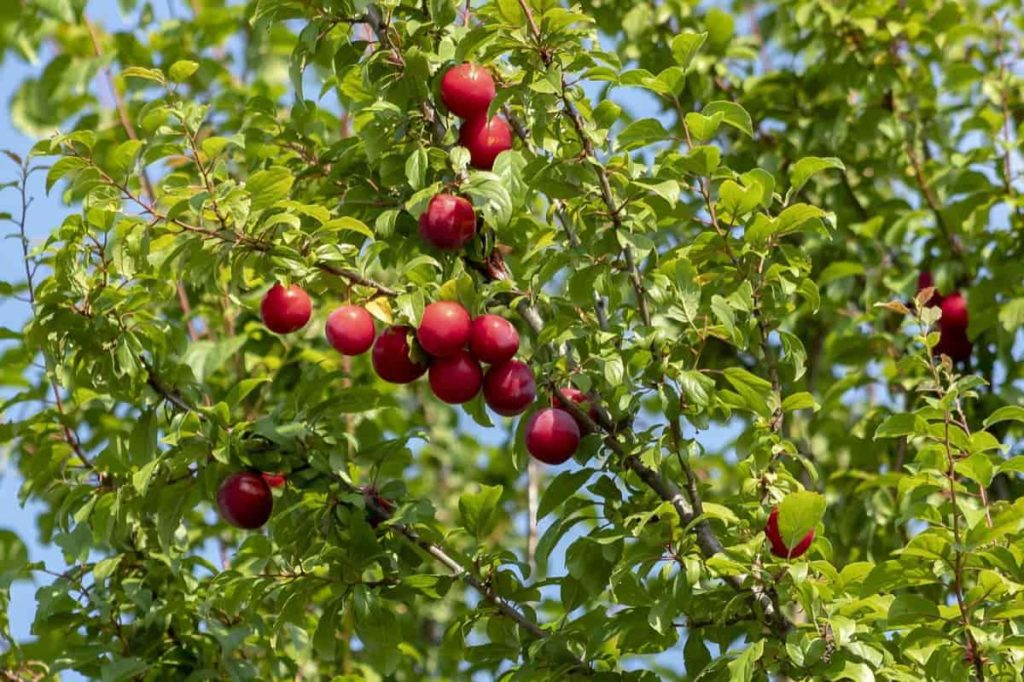
Do you need 2 Plum trees to produce fruit?
- Plum is a stone fruit that is delicious and beautiful. Most Plum trees aren’t self-pollinated, so you’ll need to plant at least two Plum trees to bear fruit. When planting a Plum tree, you must ensure that your chosen type will grow well in your climate.
- Plum trees never self-fruit, and trees need a process of cross-pollination to produce fruit, so you’ll need to plant two or more compatible varieties to set the fruit. When the tree gets four to six years old, it usually starts bearing fruit. The suitable climate, winter cold, and pruning are also necessary to ensure a good Plum crop.
- Most Plums are self-unfruitful, and trees need cross-pollination to set fruit, so you need to plant two or more compatible varieties.
When should Plum trees be planted?
- It is better to plant Plum trees as bare-rooted trees in late winter or early spring while they are dormant; this minimizes the transplantation shock and encourages the tree to start new spring growth soon after planting. When planting Plums as a container-grown or burlapped tree that is no longer dormant, plant them in spring or early summer before hot weather.
- After planting your Plum tree, it will start producing fruits for three to six years. Plum trees are usually in fruit between June and September after blooming between late winter and early spring.
Where is the best place to plant Plum trees?
Plums do not perform well when planted in heavy clay or in locations where their roots will continue to get wet. Choose a planting location that receives full sun at least 6 to 8 hours of direct sunlight. Avoid planting in low areas where frost may settle, as the frost can damage your trees. Loamy, well-drained soils are best for growing Plums.
How big do Plum trees get?
- Most Plum trees will reach 5 or 4 meters at maturity if they are of the dwarf type. If you live in a more northern climate, you may consider planting your Plum tree in a place where it will be protected from cold winds, as they are prone to late frost damage.
- Some types of Plum trees reach heights of 20 to 30 feet while others are much smaller; Flower buds on most varieties are borne on short spurs or terminal shoots of main branches.
- Generally, the plum tree reaches a mature height of 15 to 30 feet and a canopy width of 15 to 25 feet but usually becomes 15 to 25 feet long with a canopy width of up to 20 feet. In spring, they produce white flowers with pink blush, followed by an abundance of sweet, red, 1/2- to 1 and 1/2-inch-diameter Plum.
In case you missed it: 18 Common Plum Tree Problems: How to Fix Them, Solutions, and Treatment
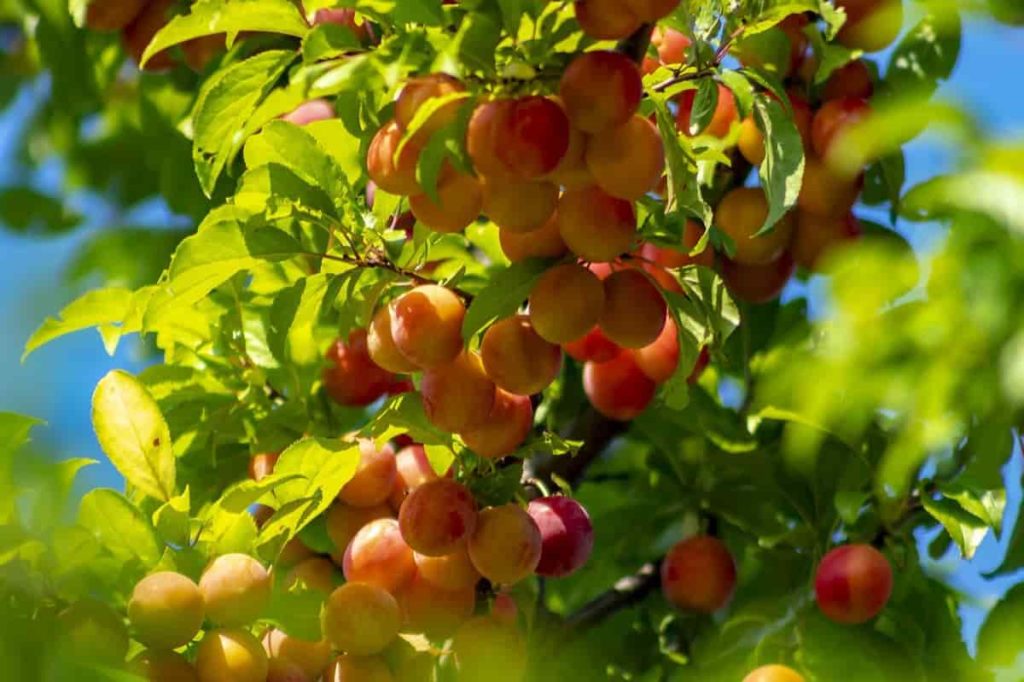
What soil do Plum trees like?
- Plums prefer slightly acid soil and thrive in lightweight loamy, well-drained soil. Plum trees grow and produce the best fruits in well-drained but moist fertile soils rich in organic matter, but bear a wide range of soils until water and nutrients are not limiting and soil pH is sufficient.
- Plums do not perform well when planted in heavy clay or in places where their roots will continue to get wet. The demand for moisture in Plums is very high, so they are best planted in loamy or clay soil. But the soil also needs to be well-drained, as Plums hate waterlogging. Before planting, you should add organic matter, such as garden compost, to sandy or shallow chalky soil.
Should you prune a Plum tree?
- Plum trees don’t require accurate pruning like Apples and Pears but still benefit from early training and thinning of old wood to ensure they produce as much fruit as possible. You should prune Plums in early spring or mid-summer to avoid infection from silver leaf disease.
- You can prune when the buds are just bursting or the tree is just beginning to flower. The established Plum trees, which are more than three years old, can be pruned in the summer, from mid-June. Then, the purpose is to keep the tree a manageable size and shape while allowing the fruit to ripen. This brings a lot of light and air into the tree. Always use disinfectant and sharp pruning shears when you trim. Do not prune Plums in winter, as it increases the risk of silver leaf infection.
What is the best fertilizer for Plum trees?
- A cup of 10-10-10 fertilizer in early spring for newly planted Plums by broadcasting it to an area about three feet across. In mid-May and mid-July, apply one-and-a-half cups of calcium nitrate or ammonium nitrate evenly over an area of about two feet. A mature Plum tree benefits from an annual application of 10-10-10 fertilizer amounting to 230 grams for each year of tree age. It can be implemented in mid-April.
- Trees require various soil amendments to improve fertility and soil conditions for optimal growth. These soil amendments include 10-10-10 fertilizers, compost, and, in some cases, sulfur and peat moss. Addressing these needs helps ensure a productive growing season.
- Keep an eye on signs of over-fertilization during the growing season. If your trees are characterized by excessive growth or leaf burning, reduce the amount of fertilizer you use in the coming year. Water the site deeply after each application of fertilizer. Spread the fertilizer evenly on the soil under the roof of each tree, but keep the fertilizer away from the stem of each tree.
Why do Plums fall off tree before ripe?
- There can be numerous reasons a Plum tree drops its fruit before ripening: pests, disease, strong winds, and stress (too much water, too little water, nutrient deficiency, poor drainage, weeds, and excessive shade).
- Plum trees produce stunting spring flowers that later grow into delicious purple fruits for you to enjoy at the end of the year. If Plums are falling from the tree before they ripen, it may be completely normal, or you may need to figure out the problem so you can decide how to prevent premature fruit drops. A fruit drop in Plum trees may be completely normal or result from poor pollination, dehydration, pests, or disease.
In case you missed it: Best Fertilizer for Plum Trees: Homemade, Organic, Compost, Natural, Liquid, When and How to Apply
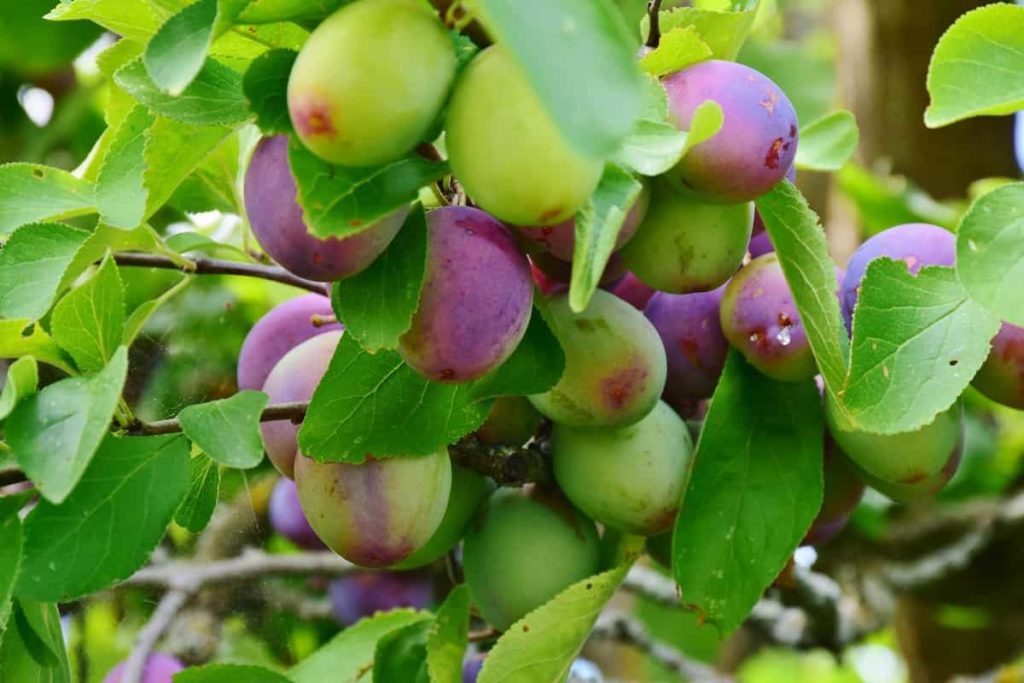
Do Plum trees need a lot of water?
- You must water Plum trees at least once weekly to promote healthy root growth. Once the tree is established, it needs regular water, especially during the dry summer. Hot, dry conditions in summer or sunscald in winter can stress the tree and cause the Plum tree to ooze sap. Similarly, frequent overwatering can weaken the tree and cause Plum tree problems.
- Water once every ten days or two weeks is enough. You can easily give more water to your Plum trees. Plums grow poorly in wet soil. Too much water prevents the roots from absorbing nutrients and oxygen.
- Be sure to water young trees heavily every week during the first growing season to help boost growth. Then, regular water. You should water the plant deeply on the soil line, then let the soil dry (though not completely) and water again.
How much space does a Plum tree need?
- You should plant standard-size trees 20 to 25 feet apart and dwarf trees 10 to 15 feet apart. Set bare-rooted trees on top of a small mound of soil in the center of the planting hole, and spread the roots down and away without unduly bending them.
- Wall-trained trees should be planted at least 8 inches from the wall so the stem can have radial growth. To minimize the root problems, dig a plantation hole about 20 to 40 centimeters away from the wall, and lean the young tree into the wall so that the roots are away from the base of the wall.
- Plum tree roots extend horizontally to the leaf canopy’s edge and up to 1 1/2 times the tree’s height. A few anchored sinker roots grow several feet down to stabilize the tree. Chances are your Plum tree has some roots that are 5 feet deep.
What should I plant next to my Plum tree?
- Yarrow, Tansy, Borage, Mint (in more shady spots), Dill, Lovage, Thyme, Lavender, and other herbs can be very beneficial in a Plum tree guild.
- Lavender repels moths away from homes. Near Plum trees growing Lavender can help keep Plums moths away or at least keep the numbers low. Lavender also attracts many beneficial pollinators to your garden. Bulbs for repelling pests and suppressing grass that competes with a young tree for nutrients.
Why does my Plum tree not produce fruit?
- The common cause of the Plum tree not producing fruit is the lack of a co-pollinator. Plums are not self-fruitful, and another species of the same species is needed nearby for pollen transfer. This is done with the help of bees, moths, and other birds.
- There are many possible reasons why your tree does not produce fruit: it can be very small; Plum trees usually start cropping at 4 or 5, depending on the rootstock used.
Why does my Plum tree have no blossom?
Flowers fall quickly due to severe cold during flowering, and a Plum tree fails to bear fruit. If you’ve just planted your Plum tree, it may take up to two years to mature and establish enough to produce flowers. Apart from this, Plum trees grow best in full sunlight. Lack of sunlight can limit the number of flowers the tree produces.
How long does it take for a Plum seed to germinate?
- Plum seeds take up to 4 months to germinate. The cold stratification takes 60 to 90 days, while the sprouting process adds another 30 days. Allow your Plum seedlings to grow in their original pots for two years.
- When planting fresh Plum seeds or pits, remove the pit and wash it in lukewarm water with a soft scrub brush to remove any pulp. The seed requires a chilling period at temperatures between 1°C to 5°C before it germinates, about 10 to 12 weeks.
- When planting fresh Plum seeds, they should be 3 inches deep in the soil. Leave the Plum pit in the winter and take care of any sprouting; then, keep the new plant moist and watch it grow.
- Plum pits or seeds need bright light and warm temperatures to germinate. An 8-inch nursery container filled with seed-starting compost or a mixture of half-potting soil and half-coarse sand works well for stratified Plum seeds to germinate; make sure there are holes under the container. Sow a Plum seed in the container at a depth of 2 inches. Set the container near a bright, sheltered spot outside or an unshaded window with bright light indoors.
- Keep temperatures around 30°C during the day and around 20°C at night so Plum seeds can germinate. Warm the pot with a propagation heating coil or mat to encourage it to germinate. Keep the soil moist but not soggy. A fresh, stratified Plum pit can take several months to germinate.
In case you missed it: Plum Gardening For Beginners, How to Start
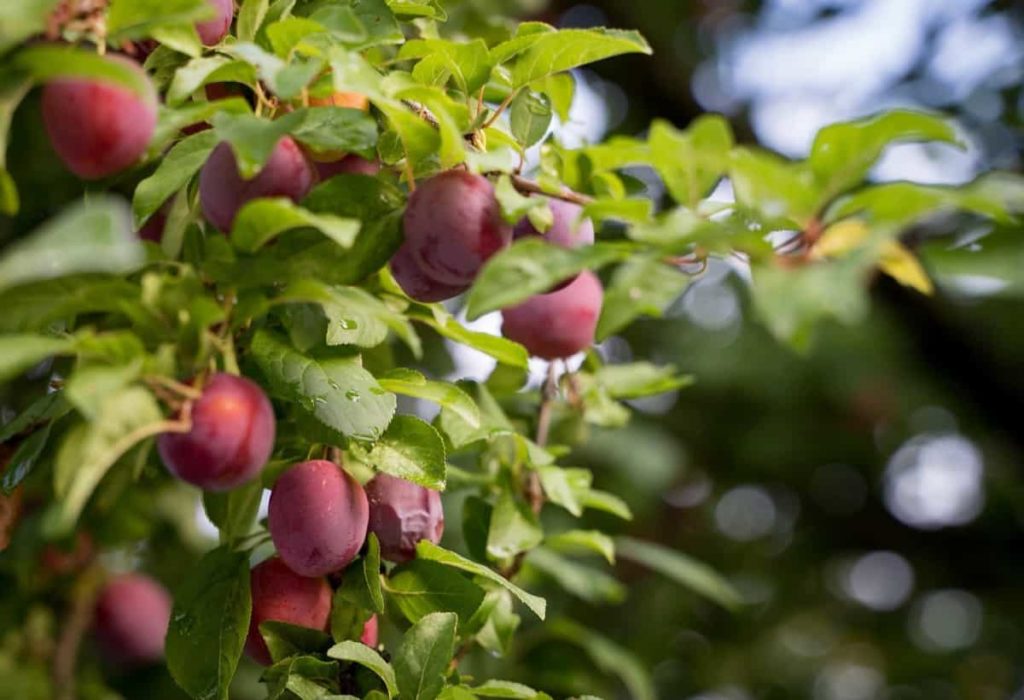
Do Plums ripen after picked?
- The Plums continue to ripen after picking. You can store plums at room temperature, away from sunlight and heat, until they are soft to the touch and have a sweet aroma. After ripening, refrigerate the Plums as needed to prevent spoiling, but cold temperatures can change their texture and taste.
- Plums are picked before ripening and will ripen if allowed to sit on the countertop for a few days. You can increase the speed of the process by placing them in a brown paper bag. Unlike Bananas and Peaches, Plums are not significantly sweet when they ripen, only softer.
- Like Nectarine and Pears, Plums complete the tree ripening cycle. That’s why you’ll usually buy them firm and allow them to sit at room temperature for a few days to soften.
What month do you pick Plums?
- Depending on your cultivar, Plums will be ready to choose from sometime between July and September. Not all Plums on a tree will ripen at the same time. Your harvest will consist of several go-throughs, each of which you will pick some fruit, a little or a lot.
- Pick Plums when they feel a little soft to the touch. They should easily get off the tree with a twist when you pick each one. You’ll choose your Plum from late spring to mid-autumn. The correct picking date depends on the types of Plums you grow and your location.
How much sun does Plum need?
Plum trees need full sun, so pick a plantation site that gets at least six hours a day. For the soil, they prefer organic matter-rich, well-drained soils. Plum trees should have at least eight hours of sunlight a day. The best soil is a fertile, humus-rich, sandy loom that is well-drained and has a slightly acidic pH of 5.5 to 6.5. Plums require chilling hours of less than 7.2°C. Plums can tolerate more summer as well as freezing winters.
Can you grow a plum tree in a container?
Plum trees can be grown in containers, but the fruit will need to be thinned to avoid the branches becoming too heavy. Thin out the fruit so that each fruit is about 2 inches apart. Plum trees need to be fertilized regularly after fruit production begins. To plant prunus trees, choose a larger-sized container, at least 18 to 20 inches better. For this, you choose plastic containers instead of clay containers, after getting a soil container plant, it becomes very heavy, and it is difficult to move.
How many Plums are on a tree?
- A well-established tree will get up to 2 bushels of Plums from late summer to autumn.
- An average of 25 to 30 kg per tree per year can be harvested depending on different types and methods of cultivation. However, it can vary widely depending on the tree and the specific type. Japanese varieties have a year of large crop followed by a light crop year, while European varieties produce a smaller but more consistent crop year after year.
In case you missed it: Plumeria Gardening For Beginners, How To Start
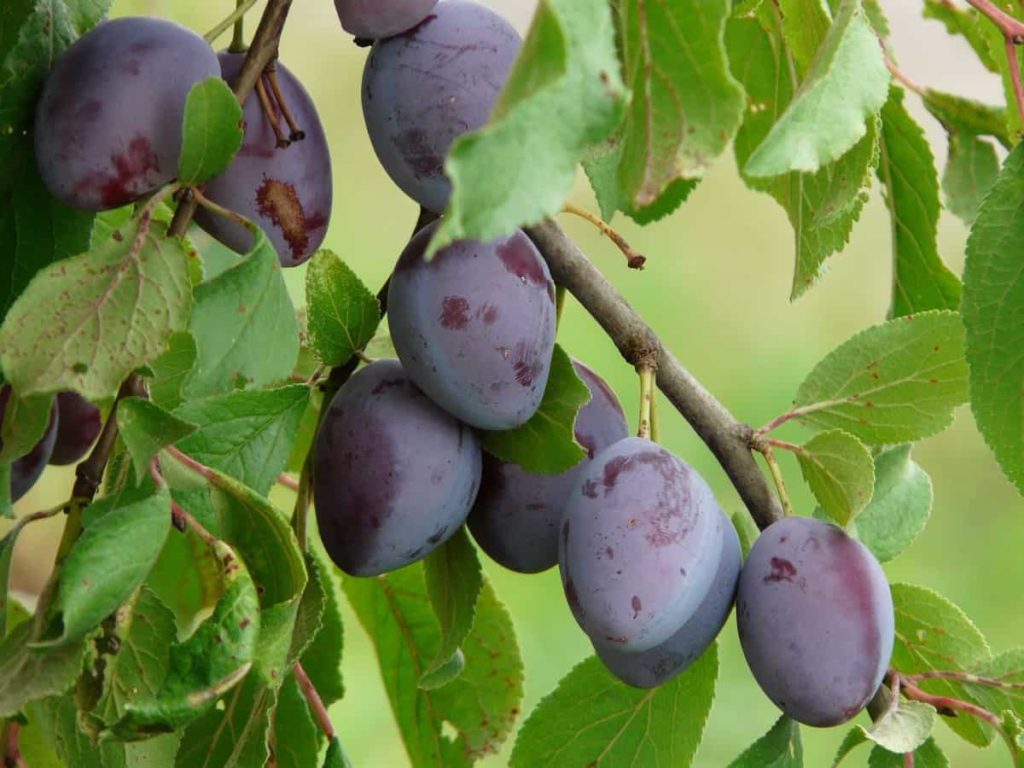
How do you protect plums?
- Like other fruit trees, plum trees benefit from a regular maintenance program of pruning, fertilizers, and preventive sprays to promote the healthiest crops. Plum trees are prone to many diseases and pests that damage the tree and fruit and act as vectors for diseases, so spraying plum trees on a regular schedule is the most important for their health.
- Once the fruit has started to develop and the husk is pulling back from the fruit, spray the plums with spinosad, esfenvalerate, or permethrin to control the twig borers. Spray again with a combination of fungicides, malathion, and sulfur to control leaf curls, plum pocket, scab, brown rot, and aphids.
Conclusion
Although today’s gardeners can choose from various hybrid plant seeds and fancy plant grafting, sometimes it’s fun to go back to the basics. Whether you’re in the mood to use what you have or want to teach your kids about the wonders of nature, you can save a Plum pit. Understanding that the Plums you buy from the supermarket are not grown from seeds is also essential.
Growers choose Plum varieties and healthy rootstock to graft and create the desired product. You can plant seeds for a delicious Plum and grow your tree that produces inedible fruits or not at all. Growing your Plum tree is a fun and exciting experience that may or may not be fruitful.
- How to Grow Hibiscus from Flower
- Plantation Ideas for Home Decoration: A Beginners Guide
- Flower Garden Designs and Layouts for Beginners
- Planting and Spacing Techniques in Papaya: A Beginner’s Guide
- Growing Gold: Essential Techniques for Planting Pineapples
- How to Make Kalanchoe Plant Bushy: Home Remedies and Solutions
- 11 Reasons Why Your Gardenia is Not Blooming: Home Remedies and Solutions
- Eco Elegance: The Guide to Designing a Drought-Tolerant Landscape
- Gardening on a Slope: Strategies for Hillside Landscaping
- Nourish and Flourish: Top Organic Mulches for Thriving House Plants
- Everything You Want to Know about Indian Mogra Flower: Discover Uses and Growing
- Green Thumb Success: Expert Tips for Cultivating Greenhouse Pumpkins All Year Round
- Maximize Growth & Flavor: The Ultimate Guide to Companion Planting in Herb Gardens
- How to Control Rhododendron Problems Naturally: Home Remedies and Organic Ways to Fix Them
- Natural Magic: The Remarkable Benefits of Cinnamon for Plants
- Best Steps to Revive Dying Tulip with Natural and Organic Treatment
- 10 Reasons Why Your Angel Trumpet is Not Blooming: Remedies and Treatment
- How to Fix Periwinkle Leaf and Flower-Related Problems: Natural Remedies and Solutions
- How to Fix Zinnias Leaf and Flower Problems: Discover Natural and Home Remedies
- Organic Steps to Induce Lemon Tree Flowers: A Comprehensive Guide
- Bloom Booster: Crafting the Perfect Homemade Bougainvillea Fertilizer
- Optimizing Growth: A Guide to Applying NPK Fertilizer for Potted Plants
- 10 Best Homemade Fertilizers for Rubber Plant: DIY Recipes and Application Method
- How to Boost Female Pumpkin Flowers: Effective Steps for More Flowers and High Yields
- Transform Your Indoor Garden: Top Benefits of Pink Salt for Houseplants
- 10 Best Homemade Fertilizers for Peacock Plants (Calathea): Easy DIY Guide
- Unlock Blooms: 9 Reasons Why Your Potted Chrysanthemum is Not Blooming
- 8 Reasons Why Your Potted Hibiscus is Not Blooming: Fix it with Simple Solutions
- Unlock Blooms: 9 Key Reasons Your Potted Frangipani Won’t Flower
- 10 Reasons Why Is My Ice Plant Not Blooming: Remedies and Treatment
- 10 Reasons Why My Potted Hydrangea Not Blooming: Treatment and Remedies
- 10 Reasons Why is My Wisteria Not Blooming: Remedies and Treatment
- 10 Reasons Why is My Goldfish Plant Not Blooming: Remedies and Treatment
- Maximize Your Space: Ultimate Guide to Balcony Gardening with Grow Bags
- 10 Reasons Why Your Iris is Not Blooming: Remedies and Treatment
- 10 Reasons Why Your Anthurium Plant is Not Blooming: Treatment and Remedies